
Streamlined Onboarding Processes
|
November 5, 2025
|
Create an Effective Onboarding Manual in 5 Simple Steps
Overview
You might be wondering how to create an effective onboarding manual. Well, it starts with:
- Defining clear objectives
- Understanding your audience
Gathering essential content is key, but it’s just as important to organize it in a way that’s easy to follow. And let’s not forget about incorporating some engaging design elements to keep things interesting!
Now, this article dives into specific strategies for each of these steps. It really emphasizes the importance of tailoring the manual to meet the needs of new employees. After all, you want them to feel welcomed and informed right from the start! Plus, keeping the manual relevant is crucial, so regular updates and collaboration with HR are a must.
So, are you ready to make your onboarding process smoother and more effective? Let’s explore how these strategies can help you create a manual that not only informs but also engages your new team members!
Key Highlights:
- Define clear objectives for the onboarding manual, focusing on what new employees should learn and achieve.
- Understand the audience's background to tailor content effectively, enhancing engagement and comprehension.
- Gather essential content reflecting the company's mission, values, job roles, responsibilities, and compliance information.
- Organise the manual with a solid table of contents, clear headings, bullet points, and visuals for easy navigation.
- Incorporate design elements that enhance user engagement, including consistent branding and interactive features.
- Regularly review and update the onboarding manual, collaborating with HR and department heads to maintain accuracy.
- Implement a version control system to track changes and ensure access to the latest manual version.
Introduction
Creating an effective onboarding manual is super important for any organization that wants to help new employees transition smoothly. You might be wondering, why is this guide so crucial? Well, it not only acts as a roadmap for new hires but also helps them get a grip on the company culture, policies, and what’s expected of them. But here’s the kicker: the real challenge is making sure that the manual is engaging, easy to understand, and regularly updated to keep up with the ever-changing workplace.
So, how can companies put together a comprehensive onboarding experience that does more than just inform? How can they inspire new team members to feel excited about their journey? Let’s dive into this together!
Define Objectives and Understand Your Audience
You might be wondering where to start with your onboarding manual. First things first, let’s nail down the primary objectives. What do you want new employees to learn and achieve during their orientation? Think about it—this could be anything from grasping the company culture to understanding their job responsibilities and key policies.
Now, let’s talk about your audience. Are they fresh out of college, seasoned pros, or folks switching gears from different industries? Tailoring your content to fit their backgrounds can really boost engagement and comprehension. And hey, why not gather some insights? You could use surveys or chat with current staff to find out what info would’ve been a game-changer during their own training. This way, you’re not just throwing content at them; you’re giving them what they really need!
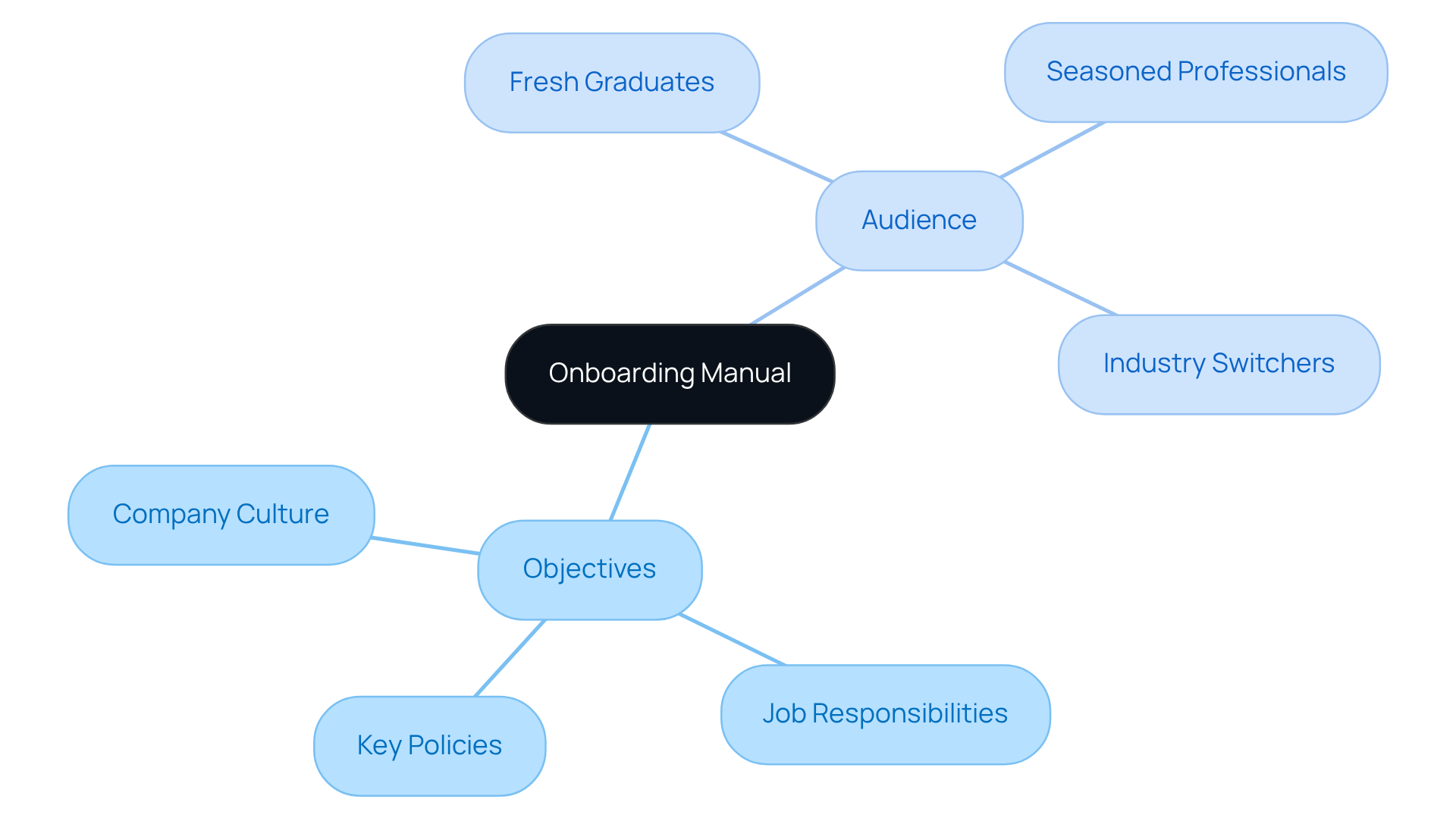
Gather Essential Content for the Onboarding Manual
Are you creating a solid onboarding manual? You might be wondering where to start! It’s all about gathering the right materials that truly reflect your organization’s vibe and how it operates. Kick things off with a summary of your company—what’s your mission? What values do you hold dear? This onboarding manual is essential for helping new employees feel at home in your culture right from the get-go.
Next up, let’s talk about job roles and responsibilities. Clear descriptions are a must! You want everyone to know what’s expected of them from day one. Don’t forget to include essential policies and procedures, plus any compliance info that’ll help new hires stick to company standards.
Now, gathering resources is just as important. Think training materials, contact lists for key folks, and links to tools or software they’ll need. Teaming up with department heads can really help ensure everything is spot-on and comprehensive. Many successful companies include their onboarding manual, which is broken down into legal, job-specific, and internal materials. The onboarding manual not only makes the onboarding process smoother but also boosts retention and satisfaction among new employees.
Speaking of making things smoother, how about adding some practical tasks for new hires to tackle during their orientation? This can really help them settle in. Remember the 5 C's of onboarding—Compliance, Clarification, Culture, Connection, and Check-back? They highlight just how crucial effective documentation is for making new hires feel like they belong and valued from day one.
By using these strategies, you can whip up a guide that not only informs but also delights your new employees, laying down a solid foundation for their success. So, what do you think? Ready to dive into creating that manual?
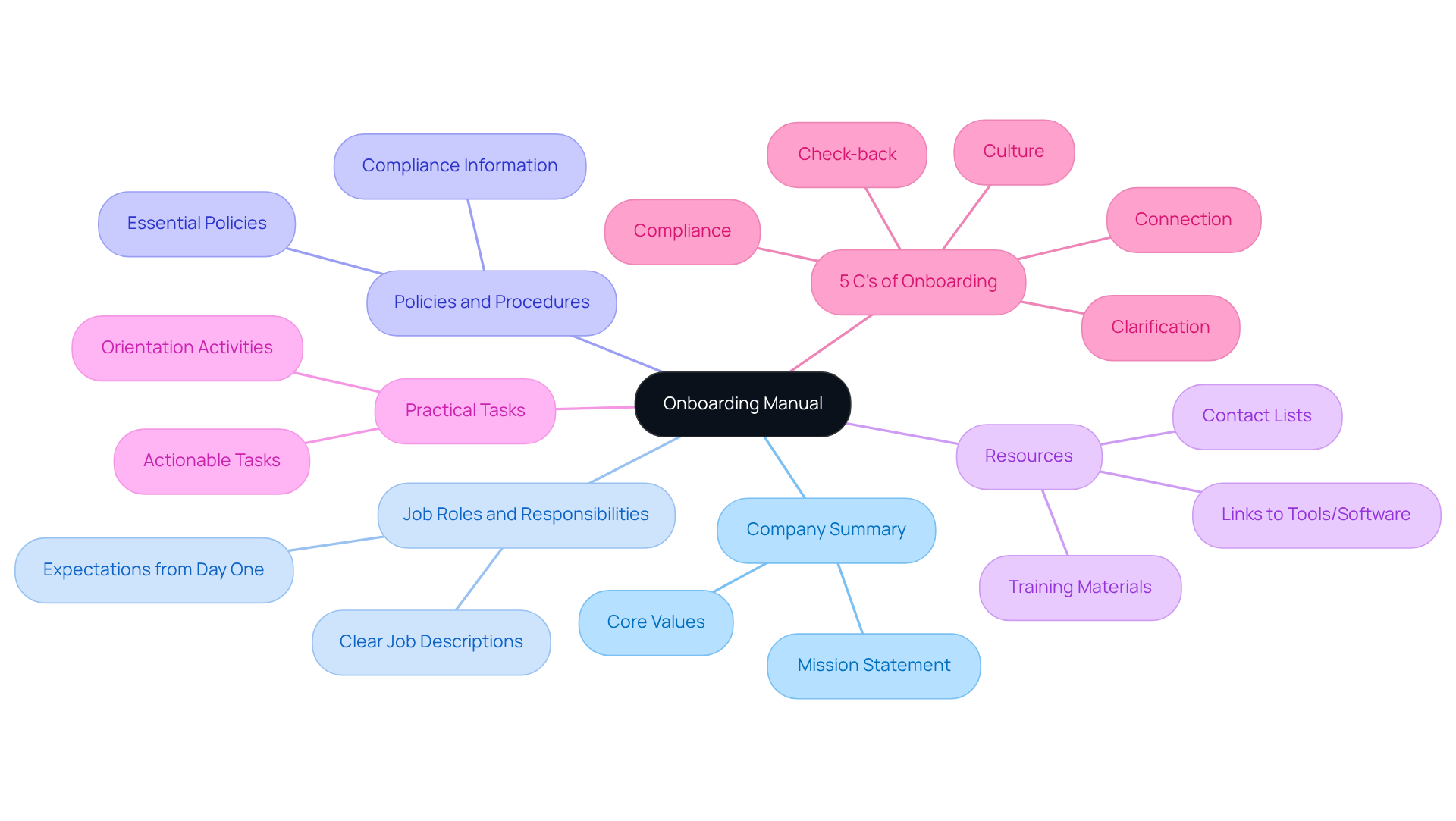
Organize Content for Clarity and Accessibility
You might be wondering how to create an onboarding manual that really works. Well, it all starts with organizing your content in a way that makes it easy to navigate. A solid table of contents is a must—it helps new hires quickly find what they need. Clear headings and subheadings are your best friends here, too. They categorize topics and make the document user-friendly. And don’t forget about bullet points! They’re perfect for lists and key info, making everything easier to read and remember.
Now, let’s talk visuals. Incorporating charts or infographics can really break up the text and clarify those tricky concepts. It makes the document more engaging, right? Plus, you want to ensure that your orientation manual is accessible in both digital and print formats. This way, you cater to different preferences and learning styles. An organized approach not only smooths out the integration experience outlined in the onboarding manual but also aligns with findings that show organizations using BambooHR can cut integration time by up to 67%!
As Max Wesman, COO at GoodHire, points out, clear guidance during the initial training period is crucial for helping new employees understand their roles. On the flip side, a messy onboarding process can lead to dissatisfaction and disengagement. That’s why effective integration practices are so important. By weaving onboarding into the work environment, as Jon Hill, Chairman and CEO of The Energists, suggests, companies can boost new hires’ comfort and productivity. This ultimately leads to better integration and performance. So, what do you think? Ready to revamp your onboarding process?
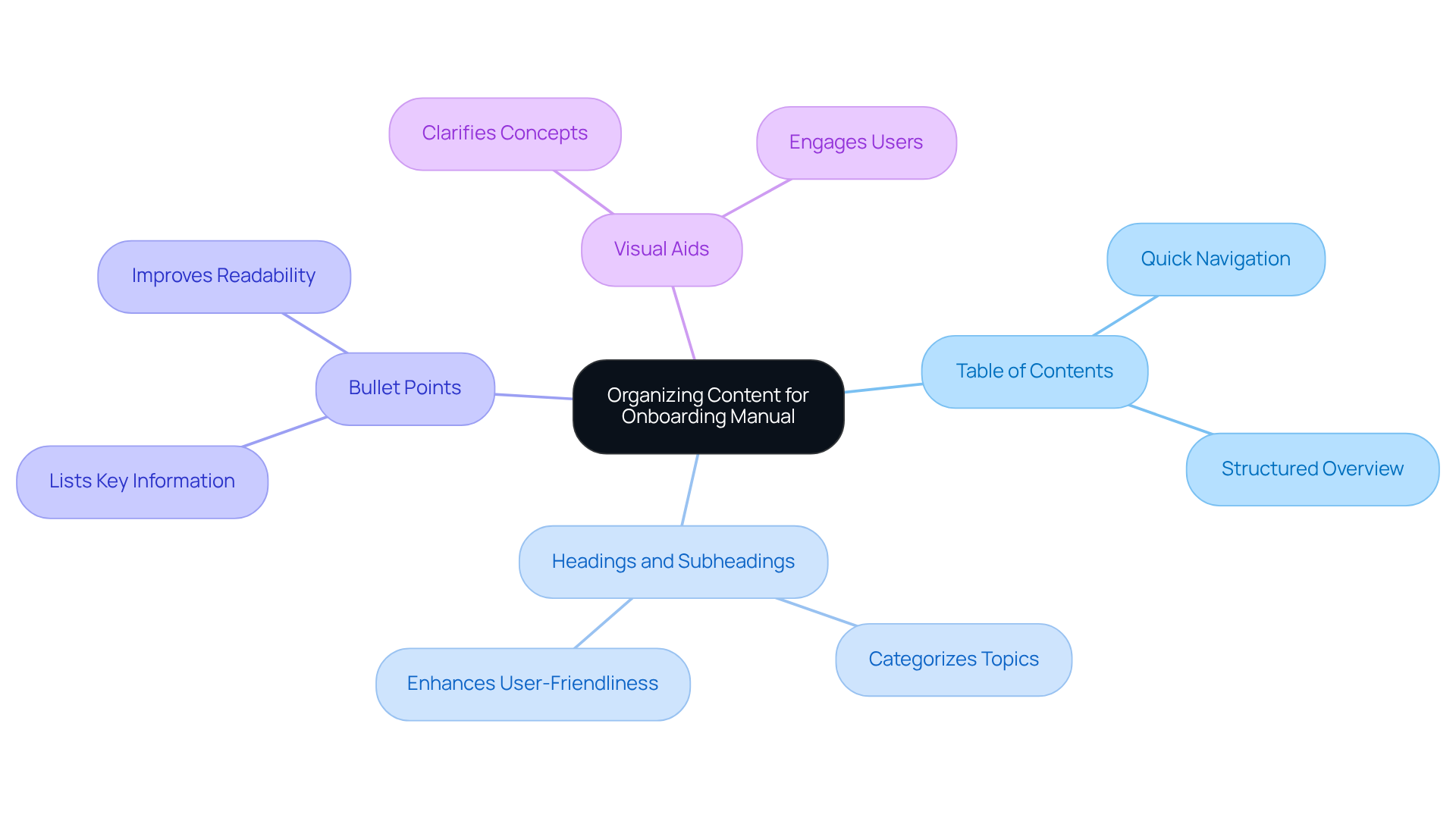
Design the Manual for User Engagement
You might be wondering how to make your documentation really pop and engage users. Start by incorporating design elements that enhance user engagement. A clean, professional layout with consistent fonts and colors that align with your company branding can work wonders. And don’t forget about interactive elements! Hyperlinks to additional resources, videos, or quizzes can really reinforce learning and keep things interesting.
Now, let’s dive into personalizing your guide. Including testimonials or quotes from current employees can offer real-world insights and make the guide feel more relatable. For instance, take it from Anastasia Masadi, a Product Owner, who says, "SowFlow has been a game changer in the way we document work and deliver to our clients. I do not have to take each screenshot separately, and do not even have to leave the browser while I am creating SOPs and training materials. SowFlow gave me time from my life back." This really emphasizes how SowFlow transforms documentation efficiency and highlights the importance of a well-structured guide.
And hey, let’s not forget about mobile users! Ensure your design is mobile-friendly by incorporating responsive layouts and accessible navigation. This way, newcomers can seamlessly access the onboarding manual on various devices. It’s all about making the experience as smooth as possible!
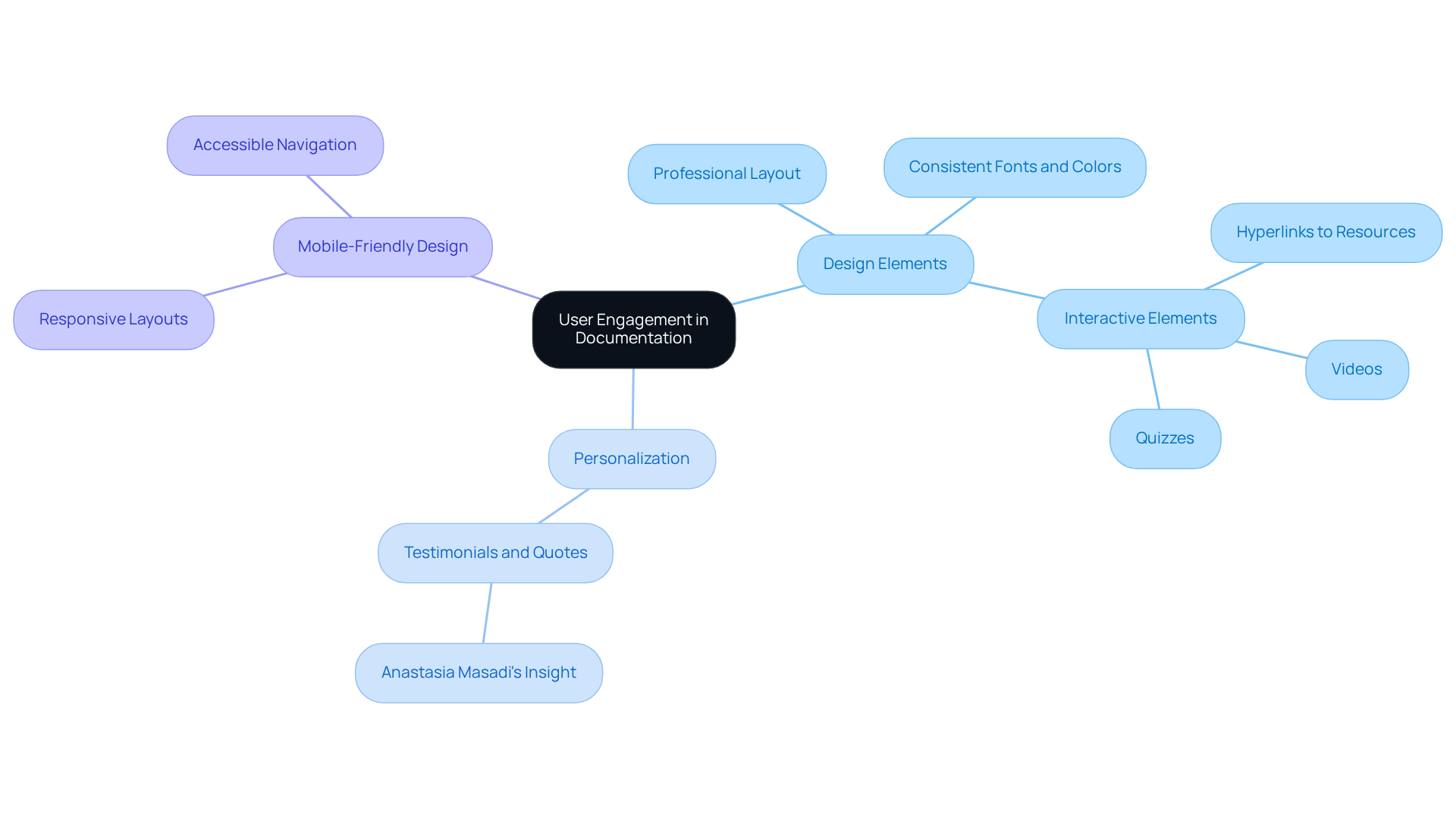
Review and Update the Onboarding Manual Regularly
You might be wondering how to keep your onboarding manual fresh and effective. Well, here’s a plan: let’s aim to review and revise it at least once a year, or whenever there are major changes in the organization. Gathering input from recent employees can really help us understand how well the guide is working and where it could use some sprucing up.
Now, collaborating with HR and department heads is key to making sure all the content stays accurate and relevant. After all, we want everyone to have the best experience possible! And speaking of keeping things organized, implementing a version control system is a smart move. This way, we can track changes easily and ensure that everyone has access to the most current version of the manual.
So, what do you think? Ready to dive into making your onboarding process even better?
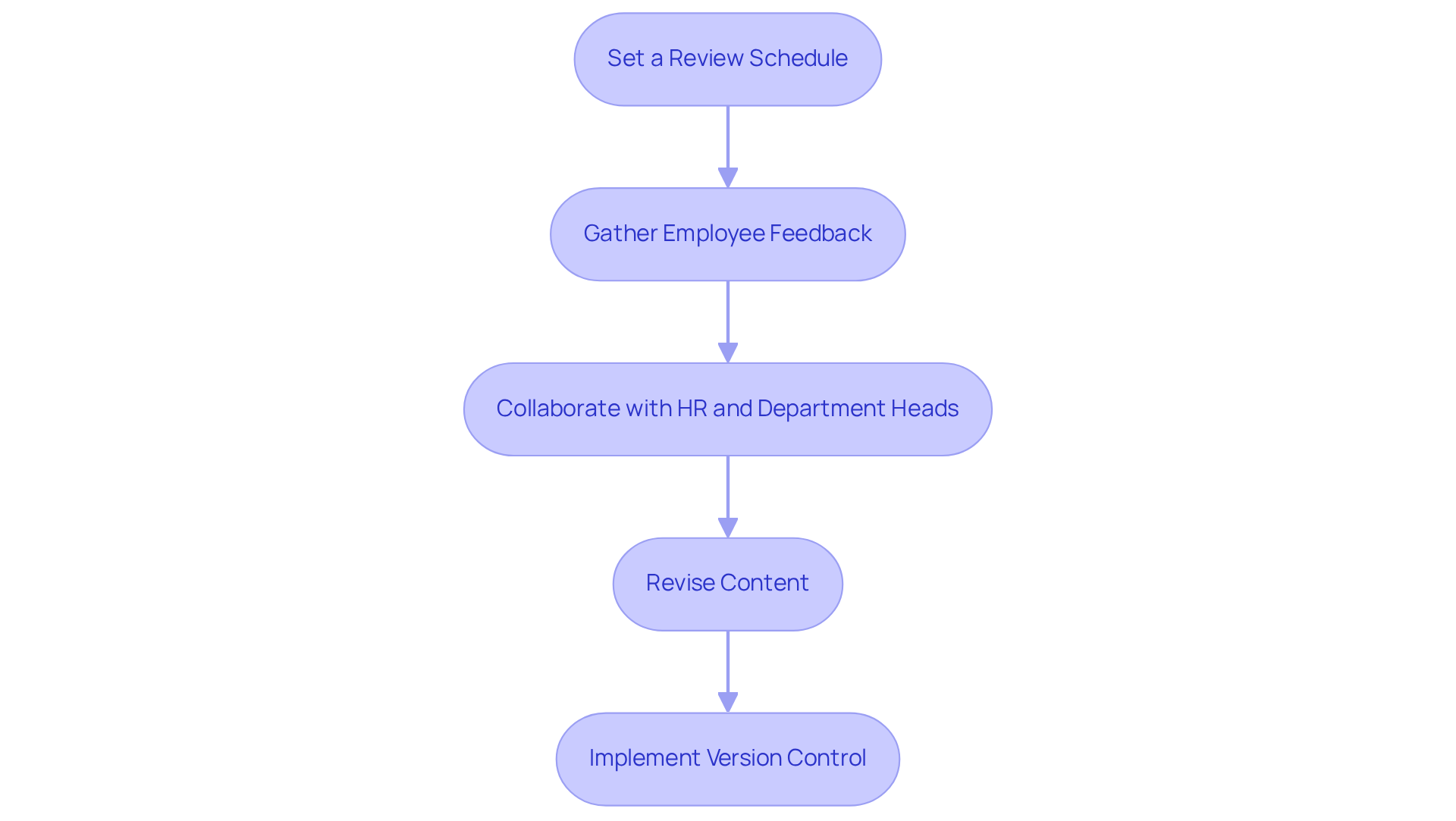
Conclusion
Creating an effective onboarding manual is super important for making sure new employees feel welcomed and ready to succeed in their roles. You might be wondering how to do that, right? Well, by defining clear objectives and really understanding your audience, organizations can tailor their onboarding processes to meet the specific needs of their new hires. This way, you’re setting the stage for a positive experience right from the start.
So, what are the essential steps for developing an onboarding manual? The article outlines five key steps:
- Identifying objectives
- Gathering relevant content
- Organizing the information for clarity
- Designing the manual for user engagement
- Committing to regular reviews and updates
Each step highlights how crucial it is to create a comprehensive and engaging document that not only informs but also inspires new employees to connect with the company culture and their responsibilities.
In summary, a well-crafted onboarding manual isn’t just a document; it’s a vital tool for boosting employee satisfaction and retention. Organizations are encouraged to take these insights and weave them into their onboarding strategies, ensuring that new hires have the knowledge and resources they need to thrive. By investing in a thoughtful onboarding process, companies can cultivate a workforce that feels valued and engaged, setting the stage for long-term success. Now, doesn’t that sound like a win-win?
Frequently Asked Questions
What should be the primary objectives of an onboarding manual?
The primary objectives of an onboarding manual should include helping new employees grasp the company culture, understand their job responsibilities, and familiarize themselves with key policies.
How can understanding the audience improve the onboarding process?
Understanding the audience allows you to tailor the content to fit their backgrounds, which can significantly boost engagement and comprehension. Gathering insights through surveys or conversations with current staff can help identify what information would have been beneficial during their training.
What essential content should be included in the onboarding manual?
The onboarding manual should include a summary of the company’s mission and values, clear descriptions of job roles and responsibilities, essential policies and procedures, compliance information, and resources such as training materials and contact lists.
Why is it important to collaborate with department heads when creating an onboarding manual?
Collaborating with department heads ensures that the content is accurate, comprehensive, and reflective of the specific needs and standards of each department, which enhances the effectiveness of the onboarding process.
What are the 5 C's of onboarding, and why are they important?
The 5 C's of onboarding are Compliance, Clarification, Culture, Connection, and Check-back. They are important because they highlight the essential elements that make new hires feel valued and help them integrate into the company effectively.
How can practical tasks benefit new hires during their orientation?
Including practical tasks for new hires can help them settle in and apply what they've learned, making the onboarding experience more engaging and effective.
👍
What others are liking
5 Steps to outline your ideal documentation structure
5 MINS READ
Where to start the your journey of mapping out your ideal documentation structure, aligning it with the very heartbeat of your organization?
Defining a winning level of detail in your process
3 MINS READ
What is too much detail, and what is too little? This article described in that winning level detail about what detail is enough.





